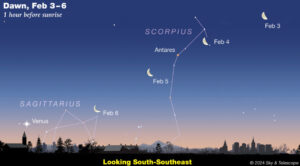Special to CosmicTribune.com, February 4, 2024
Excerpts from weekly Sky&Telescope report.
SUNDAY, FEBRUARY 4
Today is the center of winter; we cross the midpoint between the December solstice and the March equinox at 10:16 a.m. EST (15:16 UT). That minute is the very bottom of the wheel of the year, astronomically speaking.
In ancient Gaelic cultures this day was Imbolc: one of the four “cross-quarter” days between the solstices and the equinoxes.

MONDAY, FEBRUARY 5
■ Soon after dark, face east and crane your neck to look almost straight up. Or lie on your back with your feet to the east and look overhead.
That bright star there is Capella, the Goat Star. Upper right of it, by a couple of finger-widths at arm’s length, is a small, narrow triangle of 3rd and 4th magnitude stars known as “The Kids.” Though they’re not exactly eye-grabbing, they form a never-forgotten asterism with Capella.
TUESDAY, FEBRUARY 6
■ Orion is high in the southeast right after dark. Left of it is Gemini, headed up by Castor and Pollux at far left. The stick-figure Twins are still lying on their sides.
Well below their legs is bright Procyon. Standing 4° above Procyon is 3rd-magnitude Gomeisa, Beta Canis Minoris, the only other easy naked-eye star of Canis Minor. The Little Dog is seen in profile, but only his topmost outline.
■ For Easterners this evening, Io transits Jupiter’s face from 6:11 p.m. EST to 8:22 p.m. EST. The sky may still be too bright to see Io entering, but you can watch it leaving.
Io’s tiny black shadow follows behind, crossing Jupiter from 7:31 to 9:40 p.m. EST.
■ Dawn challenge: In the dawn of Wednesday morning the 7th, Venus and the very thin waning Moon are low in the southeast. Much more challenging will be fainter Mars and Mercury. They’re to Venus’s lower left, as shown below. You’ll want a flat horizon and optical aid! Good luck.

Low in dawn Wednesday morning, use Venus to guide you to the thin Moon at Venus’s lower right, and faint Mars and atmospheric-extinguished Mercury to Venus’s lower left. The three planets form a line 15° long for the next couple of mornings. That’s the width of two or three binocular fields.
WEDNESDAY, FEBRUARY 7
■ Orion is the brightest of the 88 constellations, but despite its brightness and fame, its main pattern is surprisingly small compared to some of its dimmer neighbors. The biggest of these is Eridanus the River to its west, enormous but hard to trace.
THURSDAY, FEBRUARY 8
■ Have you ever closely compared the colors of Betelgeuse and Aldebaran? Can you detect any difference in their colors at all? I can’t. Yet Aldebaran, spectral type K5 III, is often called an “orange” giant, while Betelgeuse, spectral type M1-M2 Ia, is usually called a “red” supergiant.
A complication: Betelgeuse is brighter, and to the human eye, the colors of bright objects appear, falsely, to be desaturated: looking paler (whiter) than they really are.
FRIDAY, FEBRUARY 9
■ After it’s good and dark, look due east, not very high, for twinkly Regulus. Extending upper left from it is the Sickle of Leo, a backward question mark. It’s about as long as a fist and a half at arm’s length. “Leo announces spring,” goes an old saying. Come spring, Leo will already be high.
■ New Moon (exact at 6:59 p.m. EST).
SATURDAY, FEBRUARY 10
■ Binocular observers often check in on the 5th-magnitude open cluster M41 just 4° south of Sirius. But how many then look the other way from Sirius for 6th-magnitude M50? It’s 10° north-northeast from Sirius, dimmer, smaller and more subtle than M41. Find it by sweeping first to Omicron Canis Majoris, the 4th-magnitude pointy nose of the Big Dog’s stick figure, then on again nearly as far in the same direction. It’s not exactly easy, but it’s there.
M50 really is the smaller and fainter of the two. Both clusters are at nearly the same distances from us: 2,500 light-years for M41 and 2,900 for M50.
SUNDAY, FEBRUARY 11
■ It’s not a big hop from a red supergiant, Betelgeuse, to a red dwarf nearby. Have you ever seen a red dwarf star at all? These are the most common stars in space, but they’re so intrinsically dim that not one is among the 6,000 stars visible to the naked eye on even the darkest nights. One of the nearest and brightest red dwarfs lies just 3° west of Procyon, which is nicely placed left of Betelgeuse. The shy little glimmerer is Luyten’s Star, also known as GJ 273, and at visual magnitude 9.9 it’s in range of many small telescopes

You must be logged in to post a comment Login